外研版七年级上册 Module 6 A trip to the zoo Unit 3 Language in use[1]课件(共41张PPT)
文档属性
| 名称 | 外研版七年级上册 Module 6 A trip to the zoo Unit 3 Language in use[1]课件(共41张PPT) |

|
|
| 格式 | pptx | ||
| 文件大小 | 728.5KB | ||
| 资源类型 | 教案 | ||
| 版本资源 | 外研版 | ||
| 科目 | 英语 | ||
| 更新时间 | 2023-06-15 08:36:42 | ||
图片预览

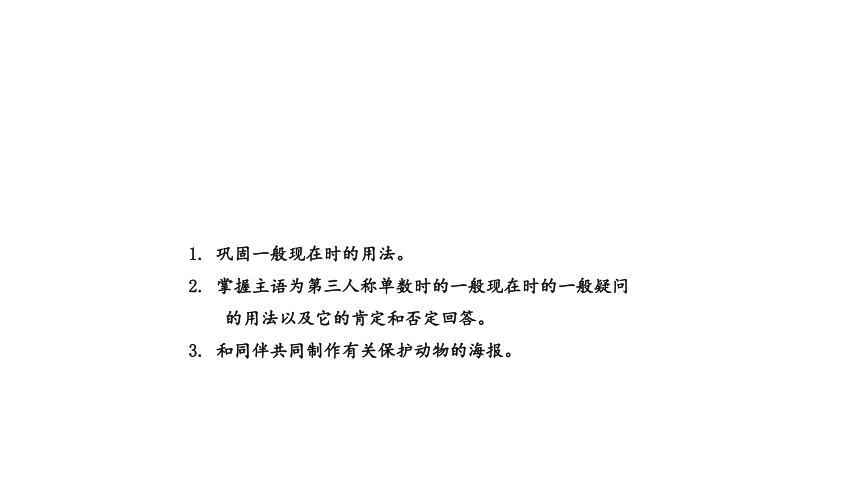
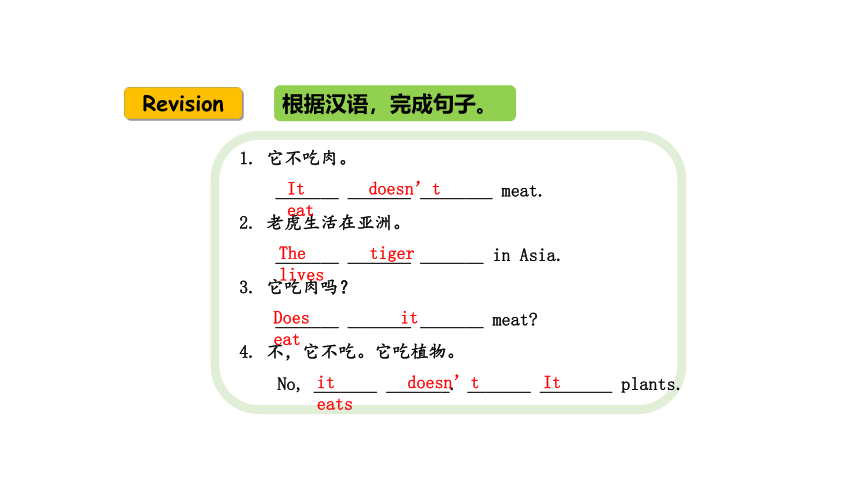

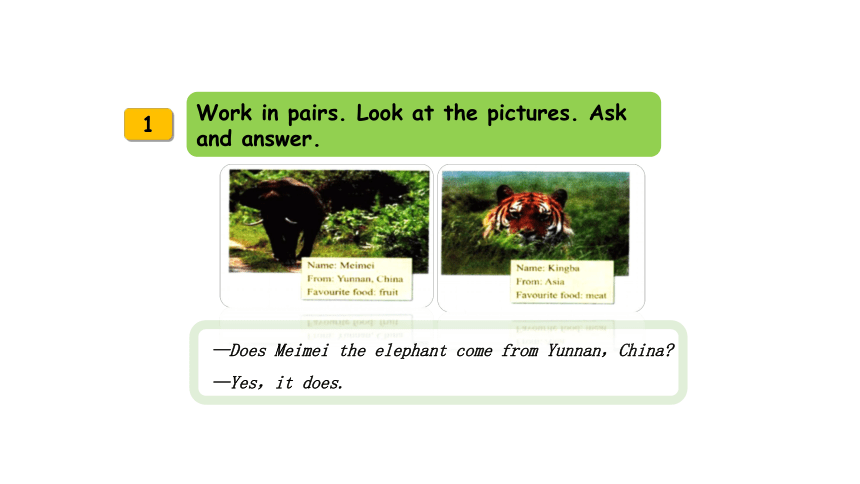
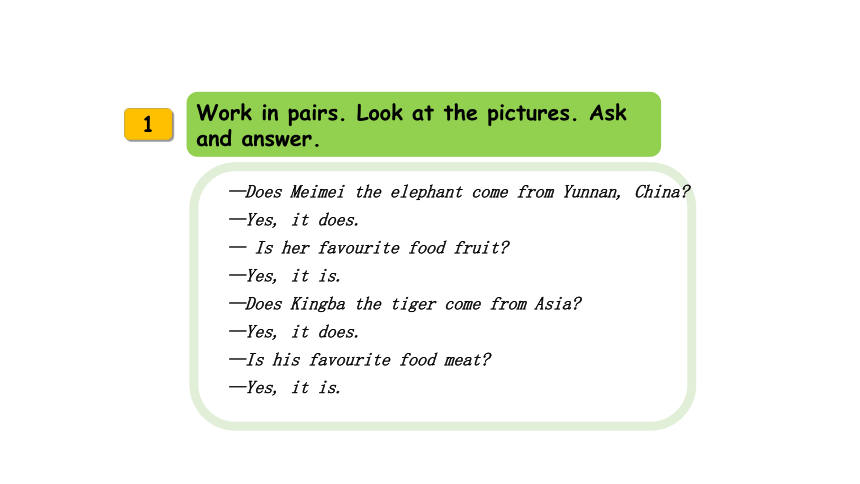
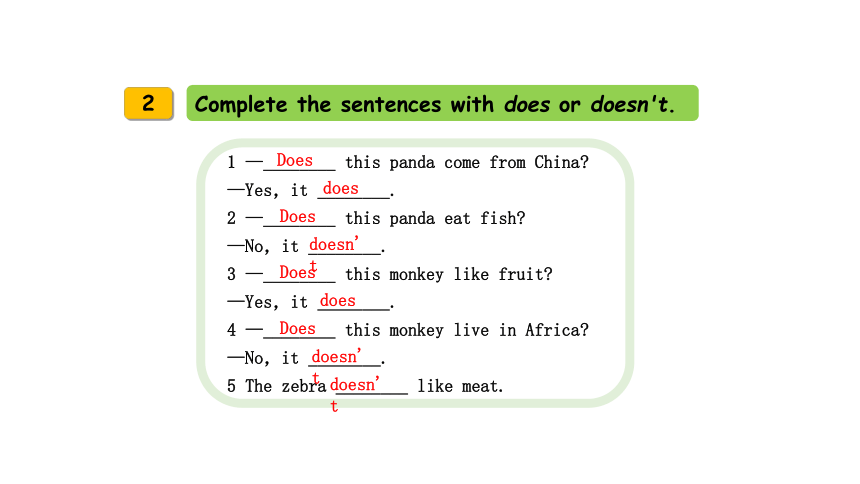
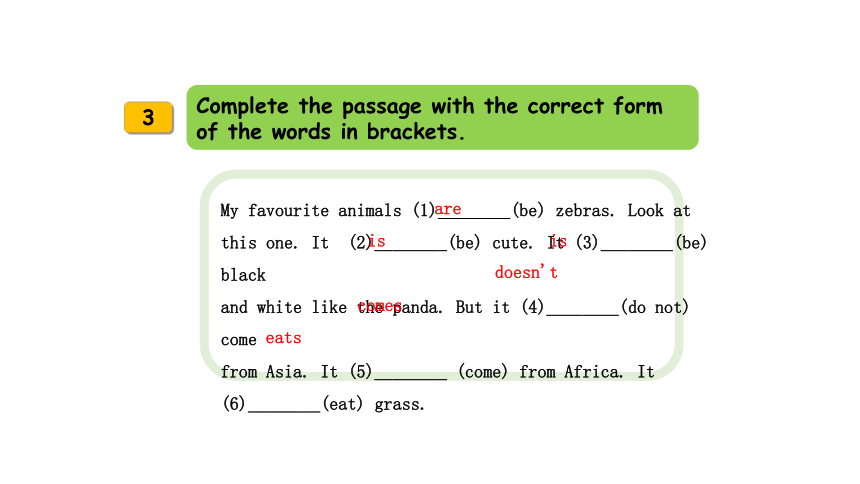
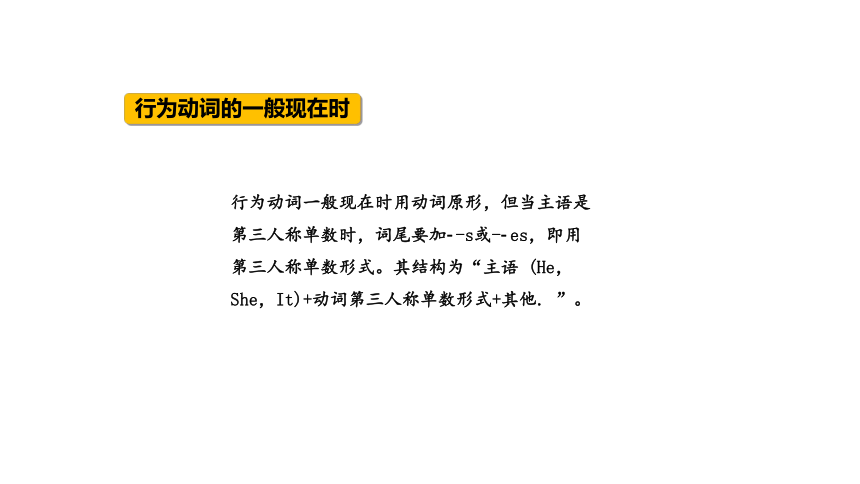
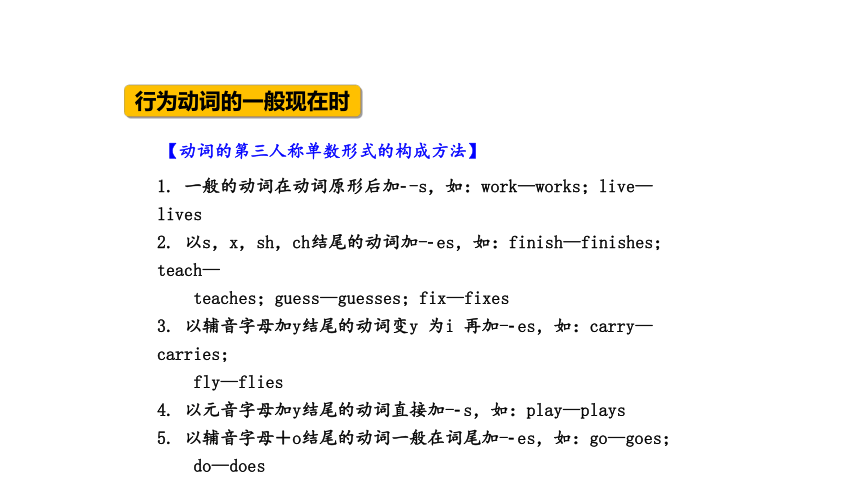
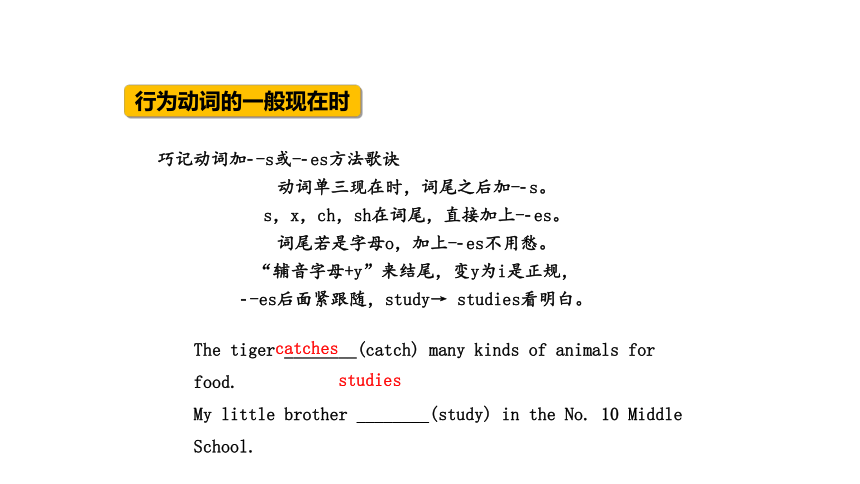
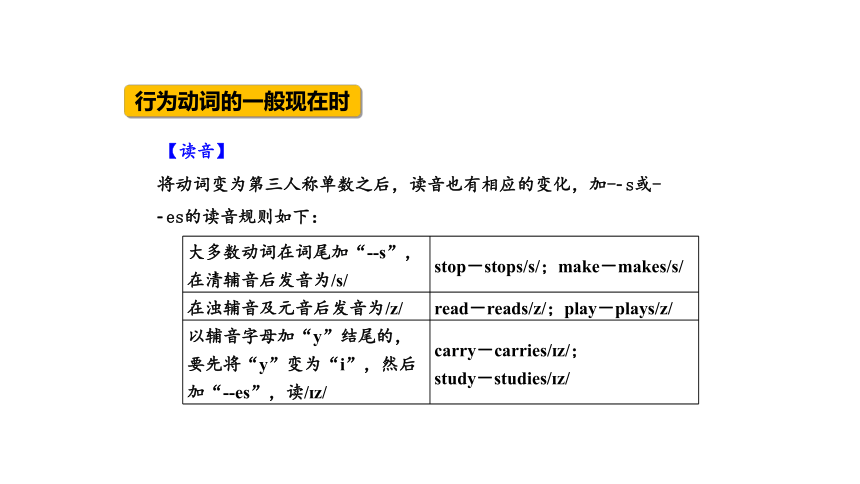
文档简介
(共41张PPT)
Module 6 A trip to the zoo
初中英语外研版七上
Unit 3 Language in use
1. 巩固一般现在时的用法。
2. 掌握主语为第三人称单数时的一般现在时的一般疑问
的用法以及它的肯定和否定回答。
3. 和同伴共同制作有关保护动物的海报。
Revision
根据汉语,完成句子。
1. 它不吃肉。
_______ _______ ________ meat.
2. 老虎生活在亚洲。
_______ _______ _______ in Asia.
3. 它吃肉吗?
_______ _______ _______ meat
4. 不,它不吃。它吃植物。
No, _______ _______. _______ ________ plants.
It doesn’t eat
The tiger lives
Does it eat
it doesn’t It eats
Language practice
It doesn't eat meat.
The tiger lives in Asia.
Does it eat meat
No,it doesn't. It eats plants.
1
Work in pairs. Look at the pictures. Ask and answer.
—Does Meimei the elephant come from Yunnan,China
—Yes,it does.
1
Work in pairs. Look at the pictures. Ask and answer.
—Does Meimei the elephant come from Yunnan, China
—Yes, it does.
— Is her favourite food fruit
—Yes, it is.
—Does Kingba the tiger come from Asia
—Yes, it does.
—Is his favourite food meat
—Yes, it is.
1 —________ this panda come from China
—Yes,it ________.
2 —________ this panda eat fish
—No,it ________.
3 —________ this monkey like fruit
—Yes,it ________.
4 —________ this monkey live in Africa
—No,it ________.
5 The zebra ________ like meat.
2
Complete the sentences with does or doesn't.
Does
does
Does
doesn't
Does
does
Does
doesn't
doesn't
My favourite animals (1)________(be) zebras. Look at
this one. It (2)________(be) cute. It (3)________(be) black
and white like the panda. But it (4)________(do not) come
from Asia. It (5)________ (come) from Africa. It
(6)________(eat) grass.
3
Complete the passage with the correct form of the words in brackets.
are
is
is
doesn't
comes
eats
行为动词的一般现在时
行为动词一般现在时用动词原形,但当主语是第三人称单数时,词尾要加 -s或- es,即用第三人称单数形式。其结构为“主语 (He,She,It)+动词第三人称单数形式+其他. ”。
【动词的第三人称单数形式的构成方法】
行为动词的一般现在时
1. 一般的动词在动词原形后加 -s,如:work—works;live—lives
2. 以s,x,sh,ch结尾的动词加- es,如:finish—finishes;teach—
teaches;guess—guesses;fix—fixes
3. 以辅音字母加y结尾的动词变y 为i 再加- es,如:carry—carries;
fly—flies
4. 以元音字母加y结尾的动词直接加- s,如:play—plays
5. 以辅音字母+o结尾的动词一般在词尾加- es,如:go—goes;
do—does
行为动词的一般现在时
巧记动词加 -s或- es方法歌诀
动词单三现在时,词尾之后加- s。
s,x,ch,sh在词尾,直接加上- es。
词尾若是字母o,加上- es不用愁。
“辅音字母+y”来结尾,变y为i是正规,
-es后面紧跟随,study→ studies看明白。
The tiger ________(catch) many kinds of animals for food.
My little brother ________(study) in the No. 10 Middle School.
studies
catches
【读音】
行为动词的一般现在时
将动词变为第三人称单数之后,读音也有相应的变化,加- s或- es的读音规则如下:
大多数动词在词尾加“ -s”, 在清辅音后发音为/s/ stop-stops/s/;make-makes/s/
在浊辅音及元音后发音为/z/ read-reads/z/;play-plays/z/
以辅音字母加“y”结尾的, 要先将“y”变为“i”,然后 加“- es”,读/ z/ carry-carries/ z/;
study-studies/ z/
行为动词的一般现在时
以“s,x,ch,sh”结尾的,在词尾加“- es”,发音为/ z/ teach-teaches / z/;
watch-watches/ z/
以“o”结尾的动词,加“- es”,读/z/ go-goes/z/;do-does/z/
以不发音字母“e”结尾的开音节词,如果尾音是/s/,/z/时,加“ -s”后字母“e”发音, 与所加“ -s” ”一起读作/ z/ close-closes/ z/
【注意】有几个动词变为第三人称单数时,原词的元音部分的发音发生了较大的变化,请注意记忆。 如:
1. do /du /-does/d z/ 2. say/se /-says/sez/)
【否定式】
行为动词的一般现在时
主语是第三人称单数时,否定句在动词原形前加助动词 does not (doesn’t)即:主语(第三人称单数)+ doesn’t +动词原形.
The boy doesn't study hard. 这个男孩学习不努力。
但如果句中用了never (从不)等词来表示否定意义时,就不能再使用助动词don't 或doesn't。一般现在时用never表示否定意义时,如果主语为第三人称单数,行为动词要加 -s 或 -es。
He never gets up early. 他从不早起。
Fred plans to work in the charity hospital in the community. (改为否定句)
Fred ________ ________ to work in the charity hospital in the community.
doesn't plan
行为动词的一般现在时
【一般疑问句及答语】
行为动词的一般现在时
主语是第三人称单数时,在变为一般疑问句时,要在句首加助动词does,
后面的谓语动词还原为动词原形。即 Does + 主语(第三人称单数)+动词
原形+其他?其肯定和否定回答用Yes,主语(第三人称单数) is. /No,主语
(第三人称单数)doesn’t. 注意回答时要用人称代词。
—Does the panda eat meat?熊猫吃肉吗?
—No,it doesn't. 不,它不吃。
—Does it eat bamboo 它吃竹子吗?
—Yes,it does. 是的,它吃。
He has dinner at home. (改为一般疑问句,并作肯定回答)
________ he _______ dinner at home
Yes,he ________.
does
行为动词的一般现在时
Does have
行为动词的一般现在时
一般现在时巧记口诀
一般现在时态中,动词一般用原形。
表述事实讲真理,习惯动作常发生。
动词词尾加 -s(-es),只表单数第三人称。
若变一般疑问句,得看句型是哪种。
系表结构和there be,be放在句首可完成;
若遇实义动词,do或does莫忘用!
4
Complete the word map.
The world
of animals
Europe
America
Asia
giraffe
monkey
panda
tiger
elephant
monkey
African
zebra
elephant
monkey
Around the world
Camels
The camel lives in the deserts of Africa and Asia and eats grass. Some people think it carries water in the humps on its back, but it's not true. In fact, it's fat.
Around the world
Kangaroos
The kangaroo is an Australian animal. It eats grass and leaves, but it doesn't eat meat. It carries its babies in a pocket on the front of its body. With its strong tail and back legs, the kangaroo jumps across the grassland.
Language Point
with sth. 用某物
【辨析】with和in
with 表示用……工具 (具体有形的工具);(表材料或内容)以/用……来填充。 He writes with a pen.
他用钢笔写字。
in 表示“以……方式;用……语言”。 What's this in English?
这个用英语怎么说?
He doesn't have a pen to write ____,but he speaks it ____ Chinese.
A. with;in B. in;with C. with;with D. in;in
A
·Talk about your favourite animal.
·Choose one animal to write about.
·Find out about the animal.
5
Work in groups. Find out about an animal.
It's big/small/tall,black and white/…
It comes from Asia/Africa/…
It eats meat/grass/bamboo/…
My favourite animal is the panda. It's big. It's black and white. It comes from Asia. It eats bamboo.
5
Work in groups. Find out about an animal.
·Draw it or find a photo.
·Write some information about it.
6
Make a poster about your group's animal.
The tiger lives in Asia. It's very large and lives alone. It's strong and it likes to eat meat.
7
Present your poster to the class.
Practice
书面表达
五要素法介绍某一动物
1. 开篇入题:多以Welcome to …等句子开头,引出下文;
2. 介绍外貌:介绍动物形体、颜色、是否强壮等;
3. 产地:介绍动物来自哪个大洲或国家;
4. 饮食及生活习惯:介绍动物的日常饮食;
5. 总结:总结全文,多以Have a good time. 等句子结尾。
…
Practice
书面表达
假如周末你在动物园做义务导游,请根据提示,向外国朋友简单介绍一下动物园里的老虎。
产地:亚洲。
饮食:肉。
生活习惯:喜欢独居;喜欢水;擅长游泳。
写作要求:介绍要全面,从老虎的产地、饮食及生活习惯等几个方面来介绍,60词左右。
———————————————————————————
Practice
参考范文
Hello,everyone. Welcome to our zoo. Look at this tiger called Huhu. It is very strong. It comes from Asia. It likes eating meat. It likes living alone. It also likes water and it is good at swimming. Don't stand near the tiger. It's very dangerous. It is also very cute. Do you like it Have a good time here.
Practice
名师点评
◆本文是用“五要素法”写作,介绍某一动物的说明文类书面表达:
开篇入题句(第1~3句)、介绍老虎的外貌(第4句)、产地(第5句)、
饮食及生活习惯(第6~8句)、总结(第9~13句)。
◆本文的添彩点:
恰当运用所学的welcome to,look at,come from,be good at等
短语来表达自己的思想。
能够正确运用所学的主语是第三人称单数时的一般现在时来介绍动物。
课堂小结
本节课主要复习巩固单元内所学词汇;学会用一般疑问句问答有关动物的问题;学会介绍动物。
Exercise
用所给词的适当形式填空
1. The tiger ____________ (not come) from Asia. It ________
(come) from Africa.
2. —_______ the monkey _______ (like) eating bamboo
—No,it ________ (like) bananas.
3. Mary __________ (not do) her homework on Saturday.
doesn't come
Does
like
likes
doesn’t do
comes
Exercise
用所给词的适当形式填空
4. She ________(watch) the kids playing in the park.
5. Jane often ________ (go) to school by bike. She ___________
(not like) going by bus.
watches
goes
doesn't like
【点拨】在一般现在时中,谓语动词为行为动词且主语为
单三形式时,其否定形式要借助于doesn't,其后
的动词变为动词原形。
1. Alice likes doing housework. She ________ her room every
afternoon.
A. cleans B. cleaned C. will clean D. has cleaned
A
【点拨】句意:艾丽斯喜欢做家务。她每天下午都打扫她的房
间。表示经常性动作常用一般现在时,句子主语She
属于第三人称单数,所以谓语动词也用第三人称单数
形式,故选A。
Exercise
单项选择
2. —Does your father like to swim in winter
—No,________.
A. it doesn't B. he isn't C. he doesn't D. he does
3. —Who cooks dinner in your family
—My mother ________.
A. does B. did C. do
C
【点拨】回答以Does开头的一般疑问句仍要用does来回答,
由No和your father可知选C。
A
Exercise
单项选择
4. Now my father ________ his bike to work every day instead of
driving.
A. ride(骑) B. rode C. rides D. will ride
5. ________ the tiger ________ in the forest
A. Is;lives B. Does;live
C. Does;lives D. Is;live
C
【点拨】考查一般现在时。主语my father是第三人称单数。
故选C。
B
Exercise
单项选择
Exercise
按要求完成句子
1. The tiger eats meat. (改为一般疑问句)
________ the tiger________ meat
2. My brother does his homework after dinner. (改为否定句)
My brother ________ ________ his homework after dinner.
3. My sister has some friends. (改为一般疑问句)
________ your sister ________ ________ friends
Does eat
doesn’t do
Does have any
Exercise
按要求完成句子
4. The kangaroo comes from Australia. (改为一般疑问句,
并作肯定回答)
—________ the kangaroo ________ ________ Australia
—________,________ ________.
5. Lingling comes to school by bike every day. (改为一般疑问句,
并作否定回答)
—________ Lingling ________ to school by bike every day
—________,________ ________.
Does comes from
Yes it does
Does come
No she doesn't
1. 熟记本单元的词汇。
2. 熟读教材P38-39中3的内容。
Homework
Protect animals, and be harmonious with nature.
保护动物,与自然和谐。
Please be good friends with animals.
请和动物,做好朋友。
Animal protection, everyone's responsibility.
保护动物,人人有责。
Remember
Thanks for listening!
Module 6 A trip to the zoo
初中英语外研版七上
Unit 3 Language in use
1. 巩固一般现在时的用法。
2. 掌握主语为第三人称单数时的一般现在时的一般疑问
的用法以及它的肯定和否定回答。
3. 和同伴共同制作有关保护动物的海报。
Revision
根据汉语,完成句子。
1. 它不吃肉。
_______ _______ ________ meat.
2. 老虎生活在亚洲。
_______ _______ _______ in Asia.
3. 它吃肉吗?
_______ _______ _______ meat
4. 不,它不吃。它吃植物。
No, _______ _______. _______ ________ plants.
It doesn’t eat
The tiger lives
Does it eat
it doesn’t It eats
Language practice
It doesn't eat meat.
The tiger lives in Asia.
Does it eat meat
No,it doesn't. It eats plants.
1
Work in pairs. Look at the pictures. Ask and answer.
—Does Meimei the elephant come from Yunnan,China
—Yes,it does.
1
Work in pairs. Look at the pictures. Ask and answer.
—Does Meimei the elephant come from Yunnan, China
—Yes, it does.
— Is her favourite food fruit
—Yes, it is.
—Does Kingba the tiger come from Asia
—Yes, it does.
—Is his favourite food meat
—Yes, it is.
1 —________ this panda come from China
—Yes,it ________.
2 —________ this panda eat fish
—No,it ________.
3 —________ this monkey like fruit
—Yes,it ________.
4 —________ this monkey live in Africa
—No,it ________.
5 The zebra ________ like meat.
2
Complete the sentences with does or doesn't.
Does
does
Does
doesn't
Does
does
Does
doesn't
doesn't
My favourite animals (1)________(be) zebras. Look at
this one. It (2)________(be) cute. It (3)________(be) black
and white like the panda. But it (4)________(do not) come
from Asia. It (5)________ (come) from Africa. It
(6)________(eat) grass.
3
Complete the passage with the correct form of the words in brackets.
are
is
is
doesn't
comes
eats
行为动词的一般现在时
行为动词一般现在时用动词原形,但当主语是第三人称单数时,词尾要加 -s或- es,即用第三人称单数形式。其结构为“主语 (He,She,It)+动词第三人称单数形式+其他. ”。
【动词的第三人称单数形式的构成方法】
行为动词的一般现在时
1. 一般的动词在动词原形后加 -s,如:work—works;live—lives
2. 以s,x,sh,ch结尾的动词加- es,如:finish—finishes;teach—
teaches;guess—guesses;fix—fixes
3. 以辅音字母加y结尾的动词变y 为i 再加- es,如:carry—carries;
fly—flies
4. 以元音字母加y结尾的动词直接加- s,如:play—plays
5. 以辅音字母+o结尾的动词一般在词尾加- es,如:go—goes;
do—does
行为动词的一般现在时
巧记动词加 -s或- es方法歌诀
动词单三现在时,词尾之后加- s。
s,x,ch,sh在词尾,直接加上- es。
词尾若是字母o,加上- es不用愁。
“辅音字母+y”来结尾,变y为i是正规,
-es后面紧跟随,study→ studies看明白。
The tiger ________(catch) many kinds of animals for food.
My little brother ________(study) in the No. 10 Middle School.
studies
catches
【读音】
行为动词的一般现在时
将动词变为第三人称单数之后,读音也有相应的变化,加- s或- es的读音规则如下:
大多数动词在词尾加“ -s”, 在清辅音后发音为/s/ stop-stops/s/;make-makes/s/
在浊辅音及元音后发音为/z/ read-reads/z/;play-plays/z/
以辅音字母加“y”结尾的, 要先将“y”变为“i”,然后 加“- es”,读/ z/ carry-carries/ z/;
study-studies/ z/
行为动词的一般现在时
以“s,x,ch,sh”结尾的,在词尾加“- es”,发音为/ z/ teach-teaches / z/;
watch-watches/ z/
以“o”结尾的动词,加“- es”,读/z/ go-goes/z/;do-does/z/
以不发音字母“e”结尾的开音节词,如果尾音是/s/,/z/时,加“ -s”后字母“e”发音, 与所加“ -s” ”一起读作/ z/ close-closes/ z/
【注意】有几个动词变为第三人称单数时,原词的元音部分的发音发生了较大的变化,请注意记忆。 如:
1. do /du /-does/d z/ 2. say/se /-says/sez/)
【否定式】
行为动词的一般现在时
主语是第三人称单数时,否定句在动词原形前加助动词 does not (doesn’t)即:主语(第三人称单数)+ doesn’t +动词原形.
The boy doesn't study hard. 这个男孩学习不努力。
但如果句中用了never (从不)等词来表示否定意义时,就不能再使用助动词don't 或doesn't。一般现在时用never表示否定意义时,如果主语为第三人称单数,行为动词要加 -s 或 -es。
He never gets up early. 他从不早起。
Fred plans to work in the charity hospital in the community. (改为否定句)
Fred ________ ________ to work in the charity hospital in the community.
doesn't plan
行为动词的一般现在时
【一般疑问句及答语】
行为动词的一般现在时
主语是第三人称单数时,在变为一般疑问句时,要在句首加助动词does,
后面的谓语动词还原为动词原形。即 Does + 主语(第三人称单数)+动词
原形+其他?其肯定和否定回答用Yes,主语(第三人称单数) is. /No,主语
(第三人称单数)doesn’t. 注意回答时要用人称代词。
—Does the panda eat meat?熊猫吃肉吗?
—No,it doesn't. 不,它不吃。
—Does it eat bamboo 它吃竹子吗?
—Yes,it does. 是的,它吃。
He has dinner at home. (改为一般疑问句,并作肯定回答)
________ he _______ dinner at home
Yes,he ________.
does
行为动词的一般现在时
Does have
行为动词的一般现在时
一般现在时巧记口诀
一般现在时态中,动词一般用原形。
表述事实讲真理,习惯动作常发生。
动词词尾加 -s(-es),只表单数第三人称。
若变一般疑问句,得看句型是哪种。
系表结构和there be,be放在句首可完成;
若遇实义动词,do或does莫忘用!
4
Complete the word map.
The world
of animals
Europe
America
Asia
giraffe
monkey
panda
tiger
elephant
monkey
African
zebra
elephant
monkey
Around the world
Camels
The camel lives in the deserts of Africa and Asia and eats grass. Some people think it carries water in the humps on its back, but it's not true. In fact, it's fat.
Around the world
Kangaroos
The kangaroo is an Australian animal. It eats grass and leaves, but it doesn't eat meat. It carries its babies in a pocket on the front of its body. With its strong tail and back legs, the kangaroo jumps across the grassland.
Language Point
with sth. 用某物
【辨析】with和in
with 表示用……工具 (具体有形的工具);(表材料或内容)以/用……来填充。 He writes with a pen.
他用钢笔写字。
in 表示“以……方式;用……语言”。 What's this in English?
这个用英语怎么说?
He doesn't have a pen to write ____,but he speaks it ____ Chinese.
A. with;in B. in;with C. with;with D. in;in
A
·Talk about your favourite animal.
·Choose one animal to write about.
·Find out about the animal.
5
Work in groups. Find out about an animal.
It's big/small/tall,black and white/…
It comes from Asia/Africa/…
It eats meat/grass/bamboo/…
My favourite animal is the panda. It's big. It's black and white. It comes from Asia. It eats bamboo.
5
Work in groups. Find out about an animal.
·Draw it or find a photo.
·Write some information about it.
6
Make a poster about your group's animal.
The tiger lives in Asia. It's very large and lives alone. It's strong and it likes to eat meat.
7
Present your poster to the class.
Practice
书面表达
五要素法介绍某一动物
1. 开篇入题:多以Welcome to …等句子开头,引出下文;
2. 介绍外貌:介绍动物形体、颜色、是否强壮等;
3. 产地:介绍动物来自哪个大洲或国家;
4. 饮食及生活习惯:介绍动物的日常饮食;
5. 总结:总结全文,多以Have a good time. 等句子结尾。
…
Practice
书面表达
假如周末你在动物园做义务导游,请根据提示,向外国朋友简单介绍一下动物园里的老虎。
产地:亚洲。
饮食:肉。
生活习惯:喜欢独居;喜欢水;擅长游泳。
写作要求:介绍要全面,从老虎的产地、饮食及生活习惯等几个方面来介绍,60词左右。
———————————————————————————
Practice
参考范文
Hello,everyone. Welcome to our zoo. Look at this tiger called Huhu. It is very strong. It comes from Asia. It likes eating meat. It likes living alone. It also likes water and it is good at swimming. Don't stand near the tiger. It's very dangerous. It is also very cute. Do you like it Have a good time here.
Practice
名师点评
◆本文是用“五要素法”写作,介绍某一动物的说明文类书面表达:
开篇入题句(第1~3句)、介绍老虎的外貌(第4句)、产地(第5句)、
饮食及生活习惯(第6~8句)、总结(第9~13句)。
◆本文的添彩点:
恰当运用所学的welcome to,look at,come from,be good at等
短语来表达自己的思想。
能够正确运用所学的主语是第三人称单数时的一般现在时来介绍动物。
课堂小结
本节课主要复习巩固单元内所学词汇;学会用一般疑问句问答有关动物的问题;学会介绍动物。
Exercise
用所给词的适当形式填空
1. The tiger ____________ (not come) from Asia. It ________
(come) from Africa.
2. —_______ the monkey _______ (like) eating bamboo
—No,it ________ (like) bananas.
3. Mary __________ (not do) her homework on Saturday.
doesn't come
Does
like
likes
doesn’t do
comes
Exercise
用所给词的适当形式填空
4. She ________(watch) the kids playing in the park.
5. Jane often ________ (go) to school by bike. She ___________
(not like) going by bus.
watches
goes
doesn't like
【点拨】在一般现在时中,谓语动词为行为动词且主语为
单三形式时,其否定形式要借助于doesn't,其后
的动词变为动词原形。
1. Alice likes doing housework. She ________ her room every
afternoon.
A. cleans B. cleaned C. will clean D. has cleaned
A
【点拨】句意:艾丽斯喜欢做家务。她每天下午都打扫她的房
间。表示经常性动作常用一般现在时,句子主语She
属于第三人称单数,所以谓语动词也用第三人称单数
形式,故选A。
Exercise
单项选择
2. —Does your father like to swim in winter
—No,________.
A. it doesn't B. he isn't C. he doesn't D. he does
3. —Who cooks dinner in your family
—My mother ________.
A. does B. did C. do
C
【点拨】回答以Does开头的一般疑问句仍要用does来回答,
由No和your father可知选C。
A
Exercise
单项选择
4. Now my father ________ his bike to work every day instead of
driving.
A. ride(骑) B. rode C. rides D. will ride
5. ________ the tiger ________ in the forest
A. Is;lives B. Does;live
C. Does;lives D. Is;live
C
【点拨】考查一般现在时。主语my father是第三人称单数。
故选C。
B
Exercise
单项选择
Exercise
按要求完成句子
1. The tiger eats meat. (改为一般疑问句)
________ the tiger________ meat
2. My brother does his homework after dinner. (改为否定句)
My brother ________ ________ his homework after dinner.
3. My sister has some friends. (改为一般疑问句)
________ your sister ________ ________ friends
Does eat
doesn’t do
Does have any
Exercise
按要求完成句子
4. The kangaroo comes from Australia. (改为一般疑问句,
并作肯定回答)
—________ the kangaroo ________ ________ Australia
—________,________ ________.
5. Lingling comes to school by bike every day. (改为一般疑问句,
并作否定回答)
—________ Lingling ________ to school by bike every day
—________,________ ________.
Does comes from
Yes it does
Does come
No she doesn't
1. 熟记本单元的词汇。
2. 熟读教材P38-39中3的内容。
Homework
Protect animals, and be harmonious with nature.
保护动物,与自然和谐。
Please be good friends with animals.
请和动物,做好朋友。
Animal protection, everyone's responsibility.
保护动物,人人有责。
Remember
Thanks for listening!
同课章节目录
- Starte
- Module 1 My teacher and my friends
- Module 2 My English lesson
- Module 3 My English book
- Module 4 My everyday life
- Module 1 My classmates
- Unit 1 Nice to meet you.
- Unit 2 I'm Wang Lingling and I'm thirteen years ol
- Unit 3 Language in use.
- Module 2 My family
- Unit 1 Is this your mum?
- Unit 2 These are my parents.
- Unit 3 Language in use.
- Module 3 My school
- Unit 1 There are thirty students in my class.
- Unit 2 The library is on the left of the playgroun
- Unit 3 Language in use.
- Module 4 Healthy food
- Unit 1 We've got lots of apples.
- Unit 2 Is your food and drink healthy?
- Unit 3 Language in use.
- Module 5 My school day
- Unit 1 I love history.
- Unit 2 We start work at nine o'clock.
- Unit 3 Language in use.
- Revision module A
- Module 6 A trip to the zoo
- Unit 1 Does it eat meat?
- Unit 2 The tiger lives in Asia.
- Unit 3 Language in use.
- Module 7 Computers
- Unit 1 How do I write my homework on the computer?
- Unit 2 When do you use a computer?
- Unit 3 Language in use.
- Module 8 Choosing presents
- Unit 1 I always like birthday parties.
- Unit 2 She often goes to concerts.
- Unit 3 Language in use.
- Module 9 People and places
- Unit 1 We're enjoying the school trip a lot.
- Unit 2 They're waiting for buses or trains.
- Unit 3 Language in use.
- Module 10 Spring Festival
- Unit 1 Are you getting ready for Spring Festival?
- Unit 2 My mother's cleaning our houses and sweepin
- Unit 3 Language in use.
- Revision module B
